
The Prittwitz family is the name of a Silesian noble family of the Wczele coat of arms, whose first documented member is one Petrus de Prawticz from 1283.

The Prittwitz family is the name of a Silesian noble family of the Wczele coat of arms, whose first documented member is one Petrus de Prawticz from 1283.

The Order of the Red Eagle was an order of chivalry of the Kingdom of Prussia. It was awarded to both military personnel and civilians, to recognize valor in combat, excellence in military leadership, long and faithful service to the kingdom, or other achievements. As with most German other European orders, the Order of the Red Eagle could be awarded only to commissioned officers or civilians of approximately equivalent status. However, there was a medal of the order, which could be awarded to non-commissioned officers and enlisted men, lower ranking civil servants and other civilians.
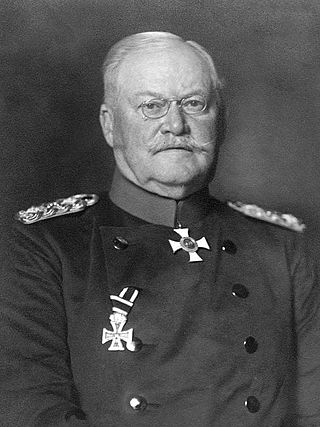
Maximilian “Max” Wilhelm Gustav Moritz von Prittwitz und Gaffron was an Imperial German general. He fought in the Austro-Prussian War, the Franco-Prussian War, and briefly in the First World War.

The House of Finck von Finckenstein is a noble family classified as Uradel. It is one of the oldest Prussian aristocratic families extant, dating back to the 12th century in the Duchy of Carinthia.

Stradomia Wierzchnia is a village in the administrative district of Gmina Syców, within Oleśnica County, Lower Silesian Voivodeship, in southern Poland.
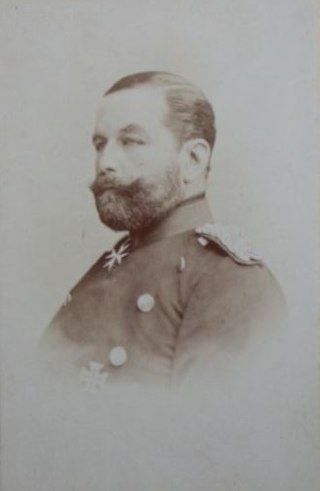
Ernst Karl Ferdinand von Prittwitz und Gaffron was a Royal Prussian Lieutenant General and Knight of Justice of the Order of Saint John.
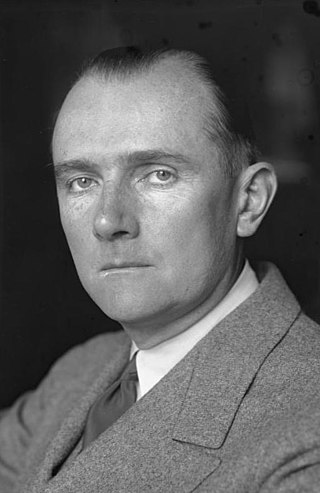
Friedrich Wilhelm von Prittwitz und Gaffron was a German Ambassador to the United States under the Weimar Republic, from 1928 until 14 April 1933. He was in office at the time that Adolf Hitler came to power in Germany, and resigned from the diplomatic corps in protest the day after Hitler was appointed Chancellor. He had hosted German Jewish playwright Lion Feuchtwanger at a dinner that day. On the day of his resignation, Prittwitz called Feuchtwanger and recommended that he not return to Germany. In 1945 he was a founding member of the Christian Social Union in Bavaria, and he served as a member of the Parliament of Bavaria from 1946 to 1954.

Moritz Karl Ernst von Prittwitz is a Royal Prussian Lieutenant-General of Infantry, who supervised the building of the large fortress in Ulm. He was later admitted to the Order of St. John as a Knight of Honor.

The Gaffron family is the name of a German noble family - classified as Uradel - from Silesia.

The Corps Borussia Bonn is a German Student Corps at the University of Bonn.

Jean de Forcade de Biaix, aka Jean de Forcade, Marquis de Biaix, aka Jean-Quirin de Forcade de Biaix, aka Jean Quérin von Forcade, Herr von Biaix, aka Johann Querin de Forcade, Herr zu Biaix, aka Johann Quirin von Forkade de Biaix, was a Huguenot, a descendant of the noble family of Forcade and Lieutenant General in the service of the Kingdom of Prussia. He was the Regimentschef of the 23rd Prussian Infantry Regiment, Commandant of the Royal Residence in Berlin, Gouverneur militaire of Berlin, a Knight of the Order of the Black Eagle a member of King Frederick I of Prussia's "Tobacco Collegium". and president of the Grand Directoire 1718–1729, the deliberative and decision-making body responsible for all Huguenot affairs in the kingdom.
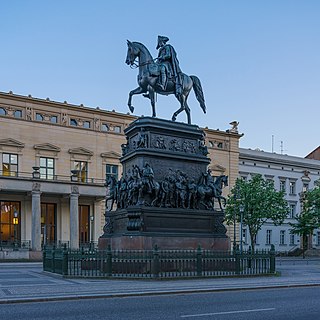
The equestrian statue of Frederick the Great on Unter den Linden avenue in Berlin's Mitte district commemorates King Frederick II of Prussia. Created from 1839 to 1851 by Christian Daniel Rauch, it is a masterpiece of the Berlin school of sculpture, marking the transition from neoclassicism to realism. The bronze statue shows "The Old Fritz" dressed in military uniform, ermine coat and tricorne hat on horseback above the leading generals, statesmen, artists and scientist of his time. Walled in during World War II, it was disassembled by East Germany in 1950, reassembled in Sanssouci Park in 1963, and returned to its original location in 1980.

Friedrich Wilhelm Quirin von Forcade de Biaix, baptized Quirin Frideric de Forcade, aka Friedrich Quirin von Forcade, aka Frédéric Quérin de Forcade, was a Kingdom of Prussia Lieutenant General, the second son of Jean de Forcade de Biaix, an early Huguenot immigrant to Brandenburg-Prussia and a descendant of the noble family of Forcade. He was one of Frederick the Great's most active and most treasured officers. He was wounded three times and once left for dead on the battlefield. Together with his wife, he fathered 23 children.
Isaac de Forcade de Biaix, aka Isaak de Forcade de Biaix, aka Isaac von Forcade de Biaix, aka Isaac von Forcade, aka Peter Isaac von Forcade, aka Isaak von Forcade, was a Kingdom of Prussia colonel, Hofmarschall to the Prince of Prussia and recipient of Prussia's highest military order of merit for heroism, Knight of the Order of Pour le Mérite. He was a descendant of the noble family of Forcade in Béarn, born as a Catholic, but emigrated to Brandenburg-Prussia at a young age, where he joined the Huguenot community in Berlin.
Friedrich Heinrich Ferdinand Leopold von Forcade de Biaix, aka Heinrich Friedrich Ferdinand Leopold von Forcade de Biaix, aka Friedrich Heinrich Ferdinand Leopold Marquis de Forcade de Biaix, was a Royal Prussian lieutenant colonel. He served in the Prussian Army from 1761 to 1793. His last command was as commanding officer of the 10th Prussian Fusilier Battalion, with which he served in the Rhine Campaigns of 1791, where he was awarded the Kingdom of Prussia's highest military order of merit for heroism, Knight of the Order of Pour le Mérite (1791). He left the Prussian Army after 32 years of service in 1793 as the result of invalidity. At the time of his death, he was the owner of Schleibitz Manor, near Oels, Silesia.
Friedrich Wilhelm Leopold Konstantin Quirin Freiherr von Forcade de Biaix, aka Friedrich Wilhelm Leopold Konstantin Quirin von Forcade de Biaix, Herr of Schleibitz, Hamm, Groß-Naedlitz and Loslau, aka the Baron von Forcade,, Royal Prussian Major, Knight of the Iron Cross 2nd Class on 26 August 1813, knighted by His Majesty Frederick William III of Prussia as Knight of the Order of Saint John in 1817, Royal Prussian Chamberlain (Kammerherr) and Castellan (Drost) of Neuenrade in the County of Mark, after his father's death in 1808. He was also a publisher, author, and theater director.
Friedrich Wilhelm von Forcade de Biaix, aka Frideric Guillaume de Forcade was a Royal Prussian Colonel, Schwadronschef of the 2nd Grenadier Company in the 24th Prussian Infantry Regiment, recipient of the Kingdom of Prussia's highest military order of merit for heroism, Knight of the Order of Pour le Mérite (1774), Commandant of Frankfurt/Oder, and Presbyter of the French congregation of Frankfurt/Oder.
Friedrich Wilhelm Ferdinand Ernst Heinrich von Forcade de Biaix, aka Ferdinand von Forcade, Royal Prussian Major and Knight of the Iron Cross 2nd Class.
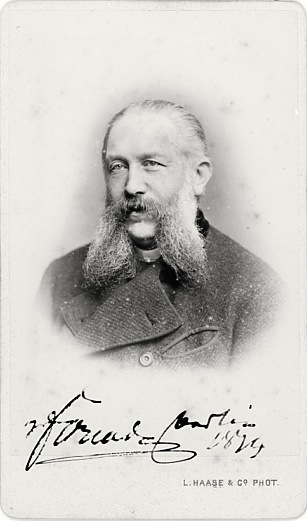
Christoph Ernst Friedrich von Forcade de Biaix was a German Rittergut owner, Appellate Court Judge in Hamm, Supreme Court Judge in Berlin and Member of parliament in the German Reichstag.
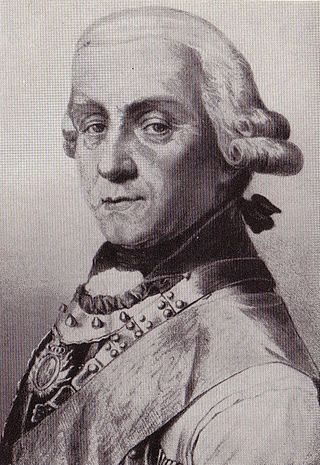
Joachim Bernhardt von Prittwitz and Gaffron (1726–1793) was a Prussian officer credited with saving the life of Frederick the Great at the Battle of Kunersdorf. At the time, he was a cavalry captain in Hans Joachim von Zieten's Hussar regiment. He became the head of gendarmes regiment, and inspector general of the cavalry of Brandenburg March and Magdeburg in 1775. He was promoted to lieutenant general in 1785 and general of cavalry in 1788. Frederick awarded him the Order Pour le Mérite and the Order of the Black Eagle. In 1851, Prittwitz was included on the panels of the Equestrian statue of Frederick the Great as one of the key figures in the establishment of the Prussia state.

Wilhelm Ludwig Karl Kurt Friedrich von Tümpling was a Prussian General der Kavallerie. Tümpling commanded a division in the Austro-Prussian War and VI Army Corps during the Franco-Prussian War.